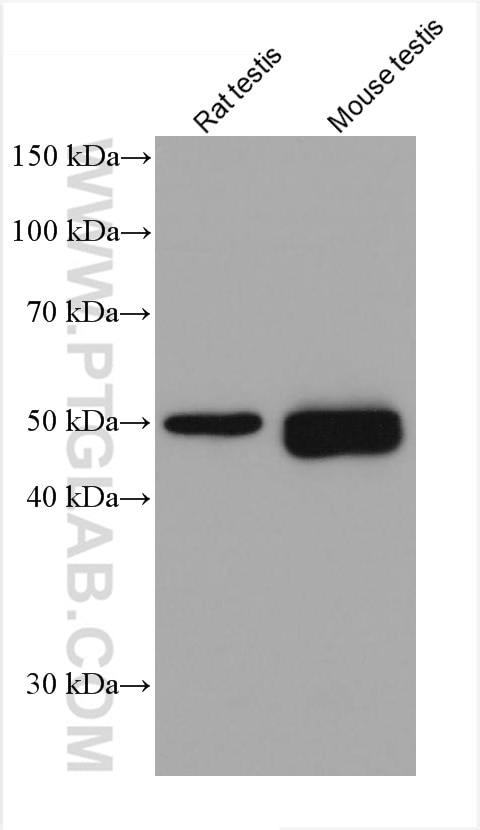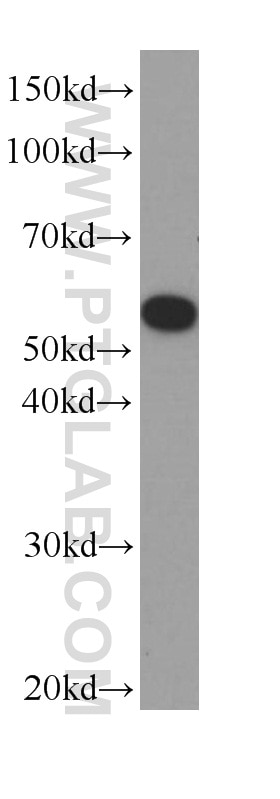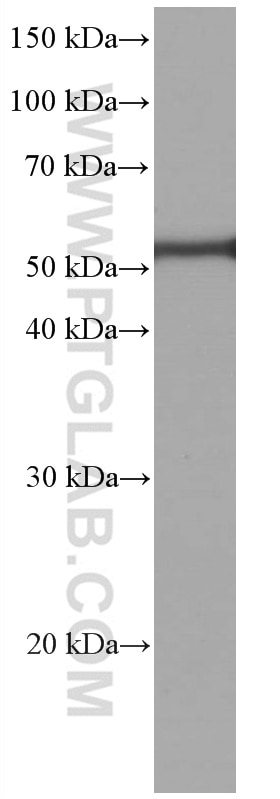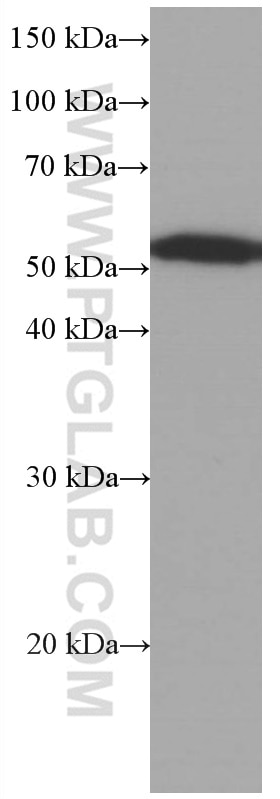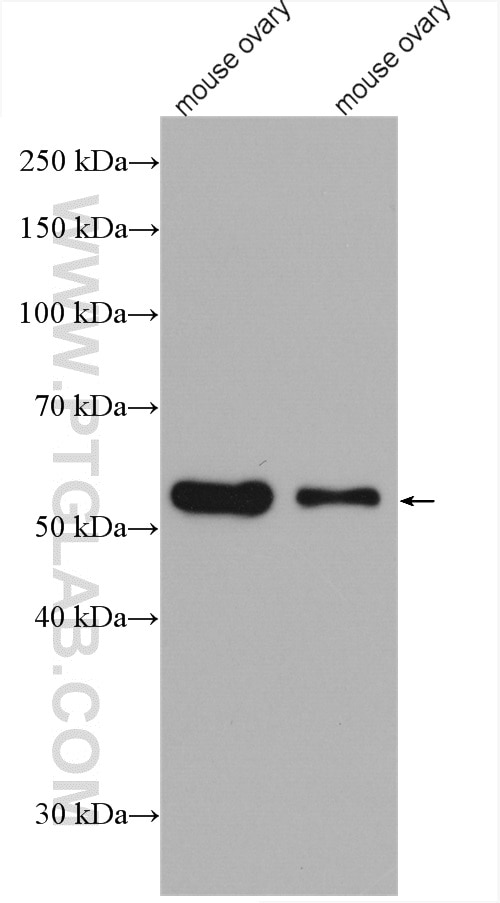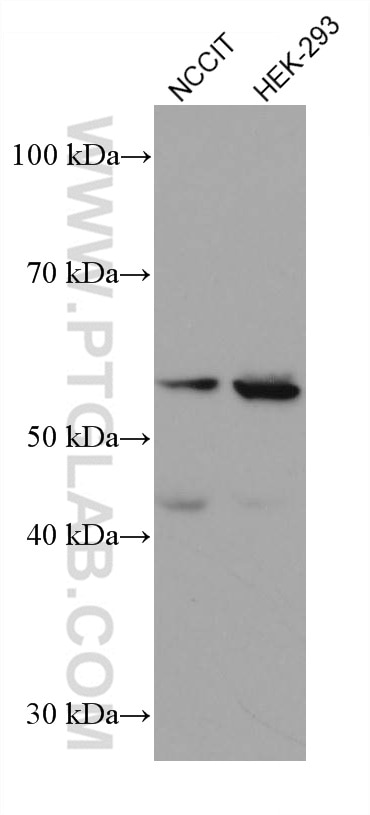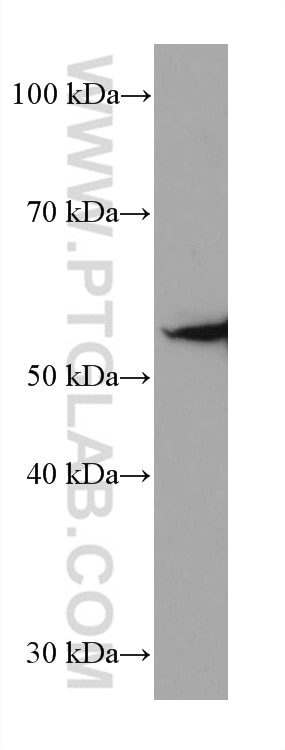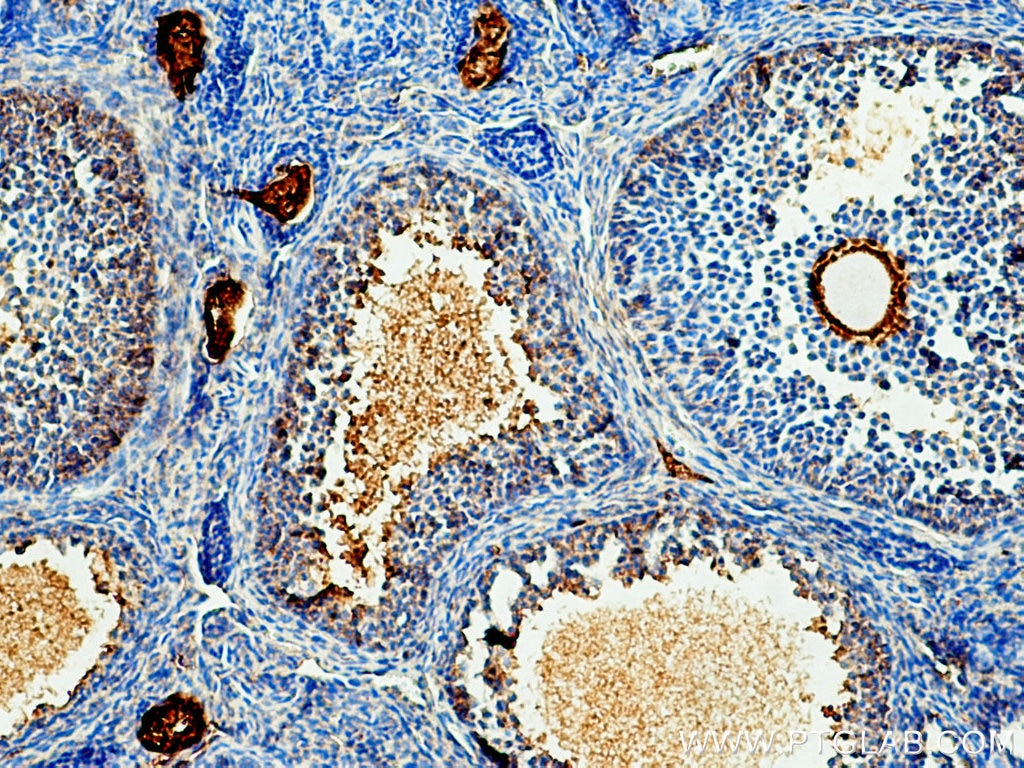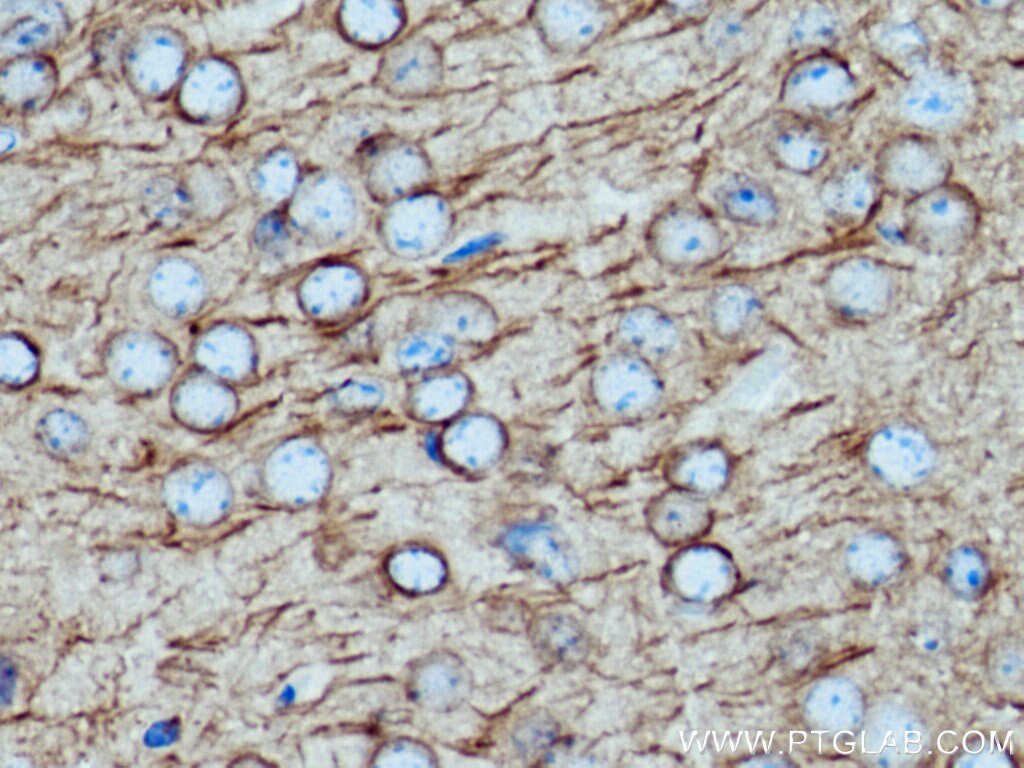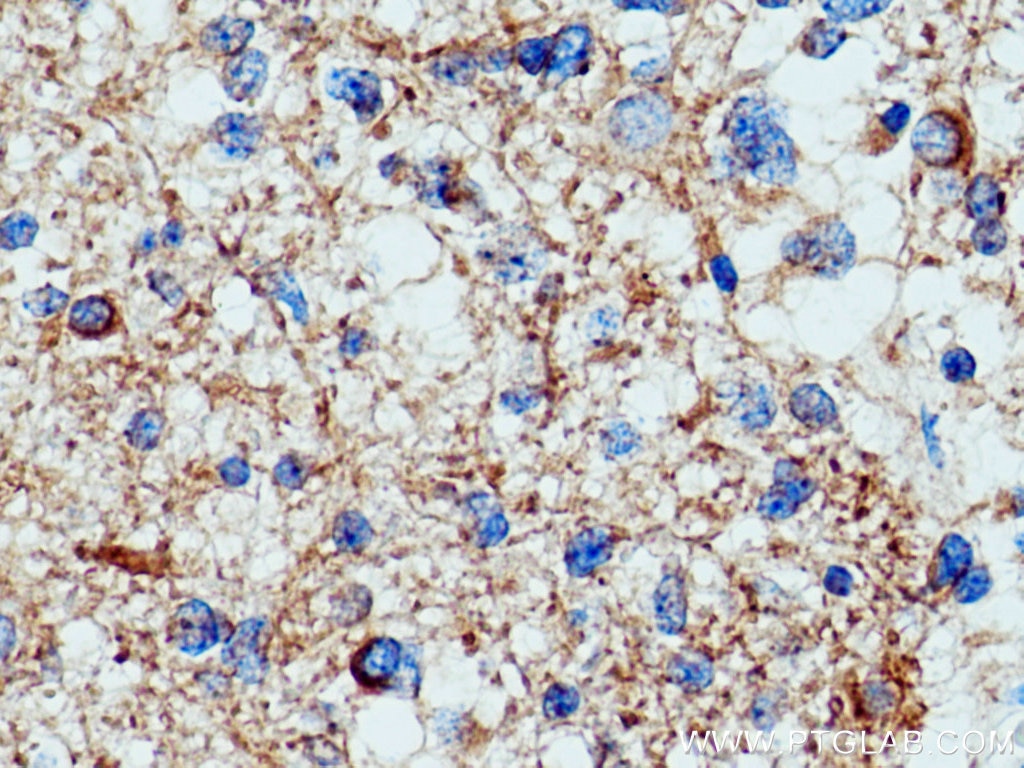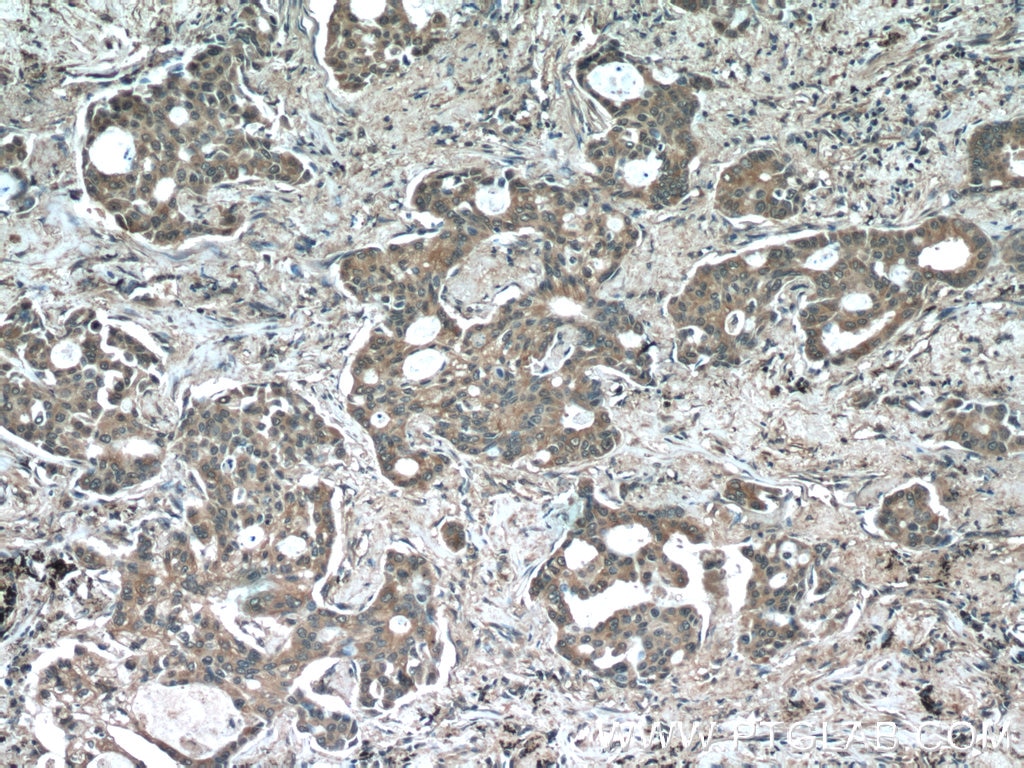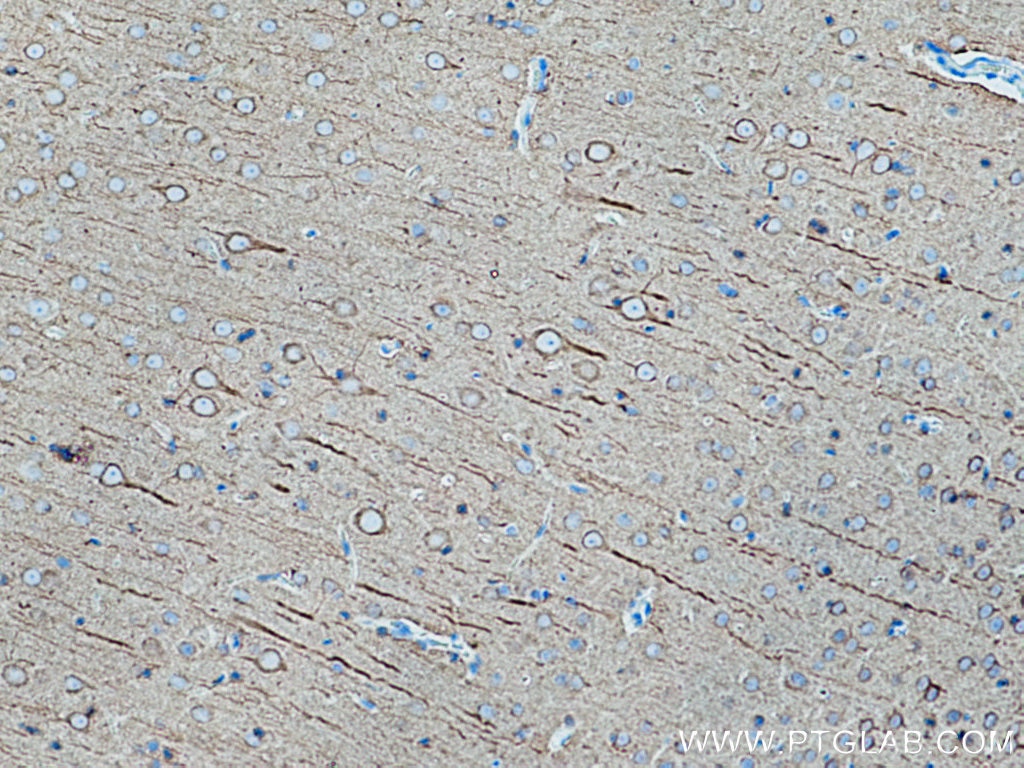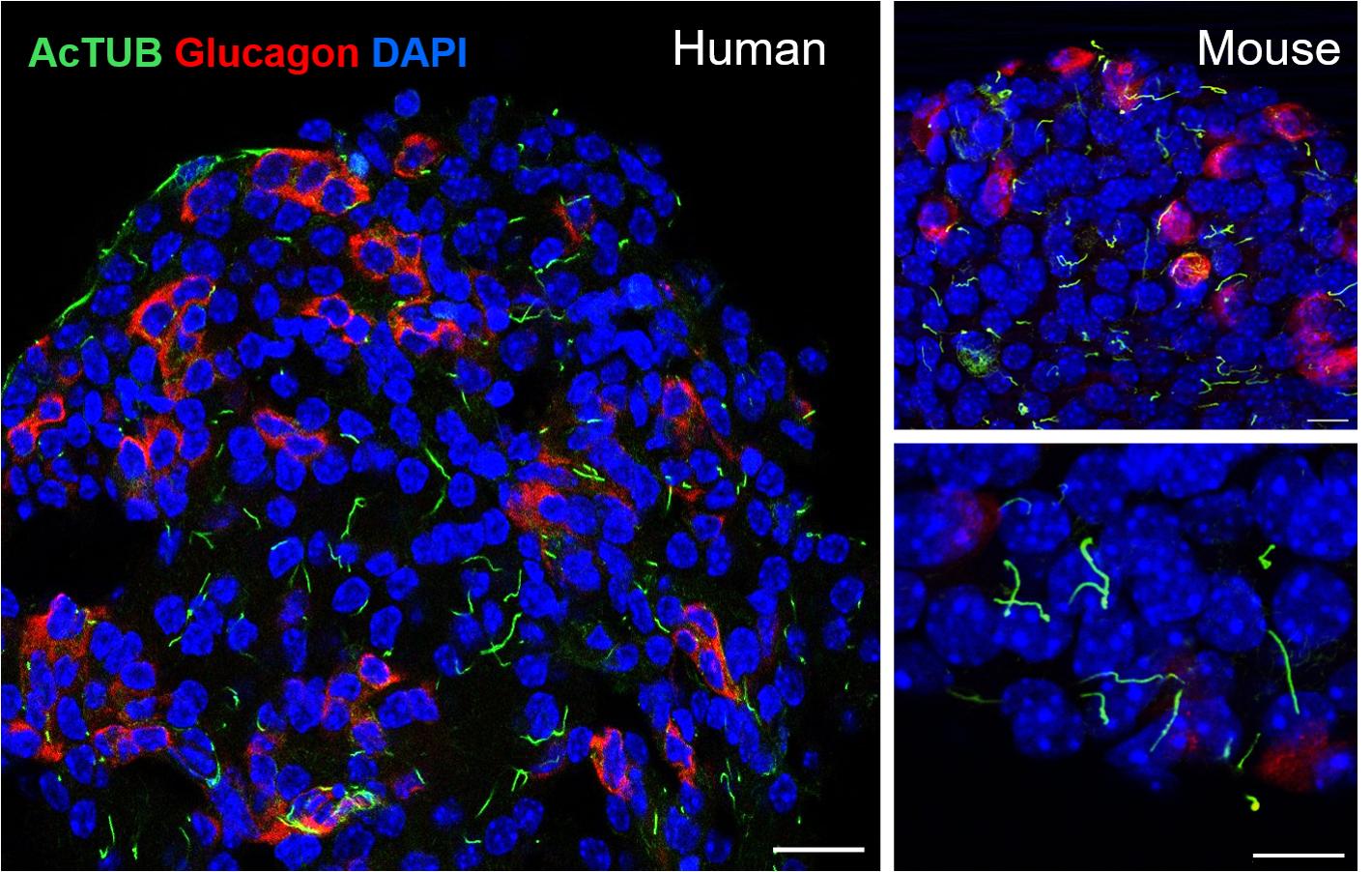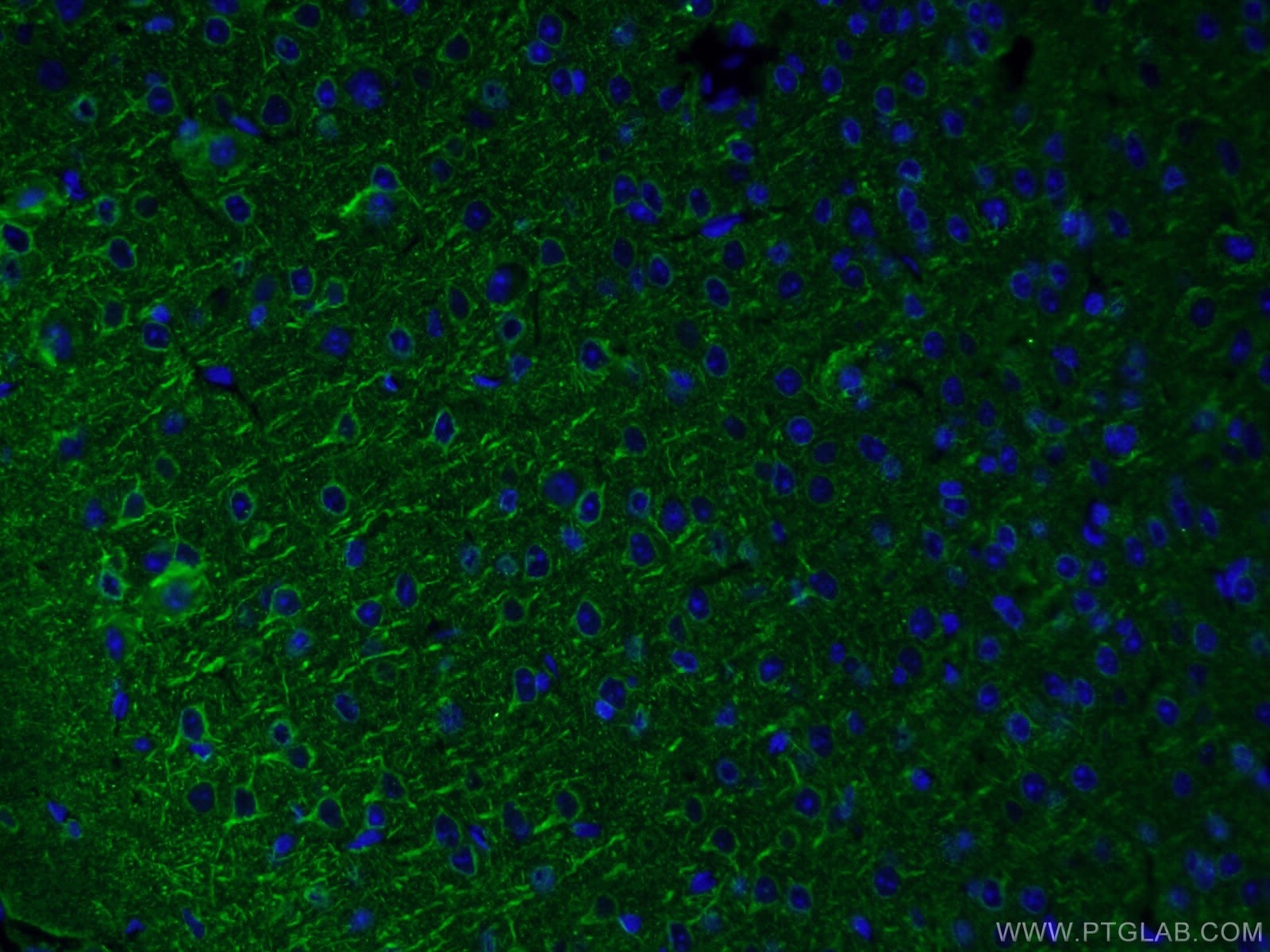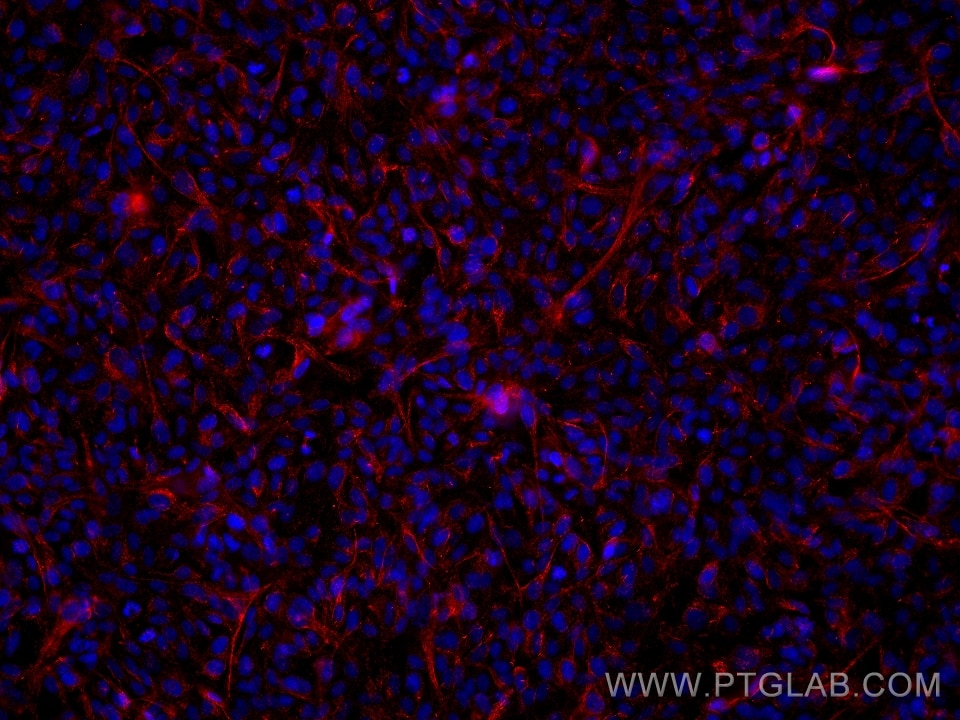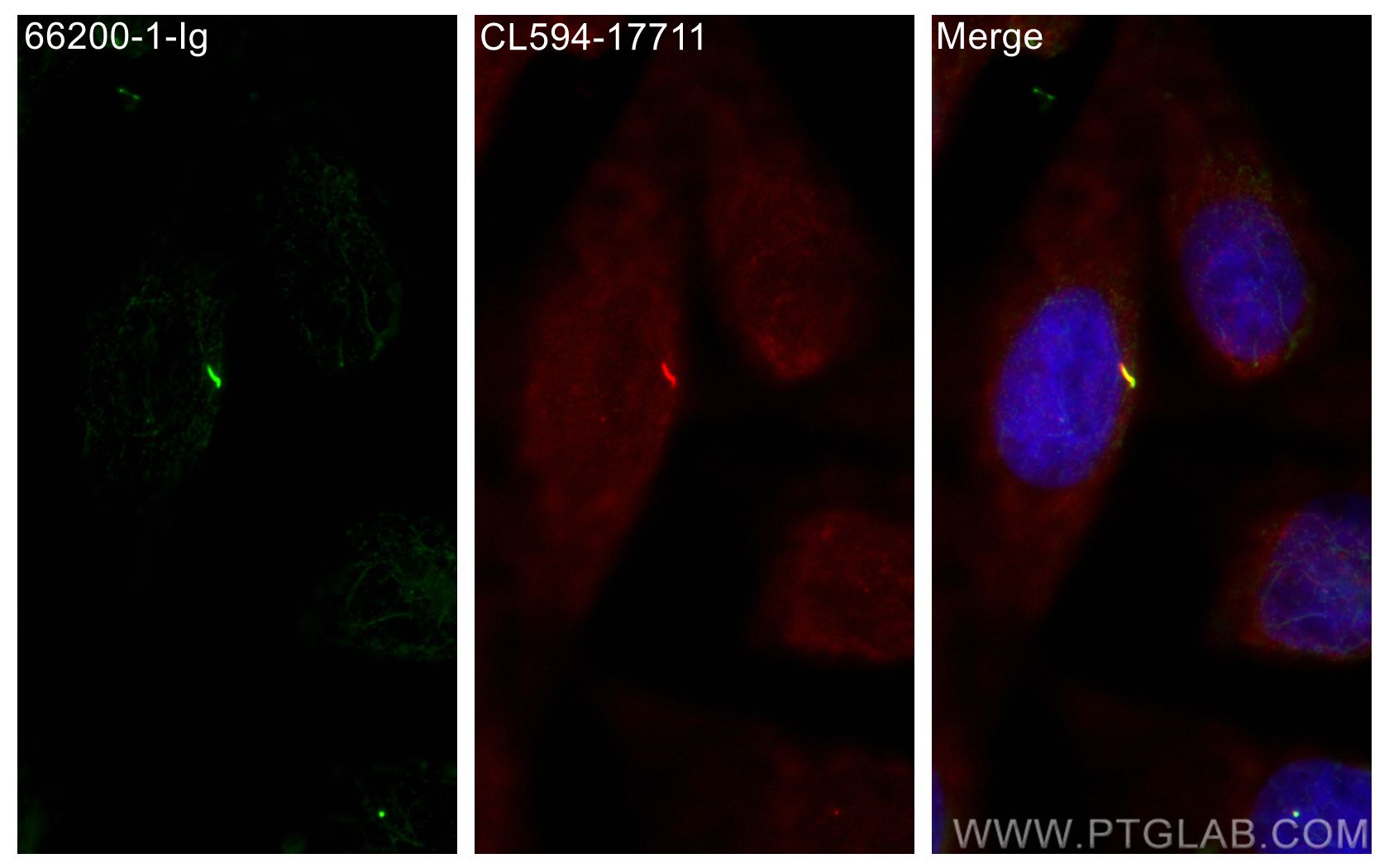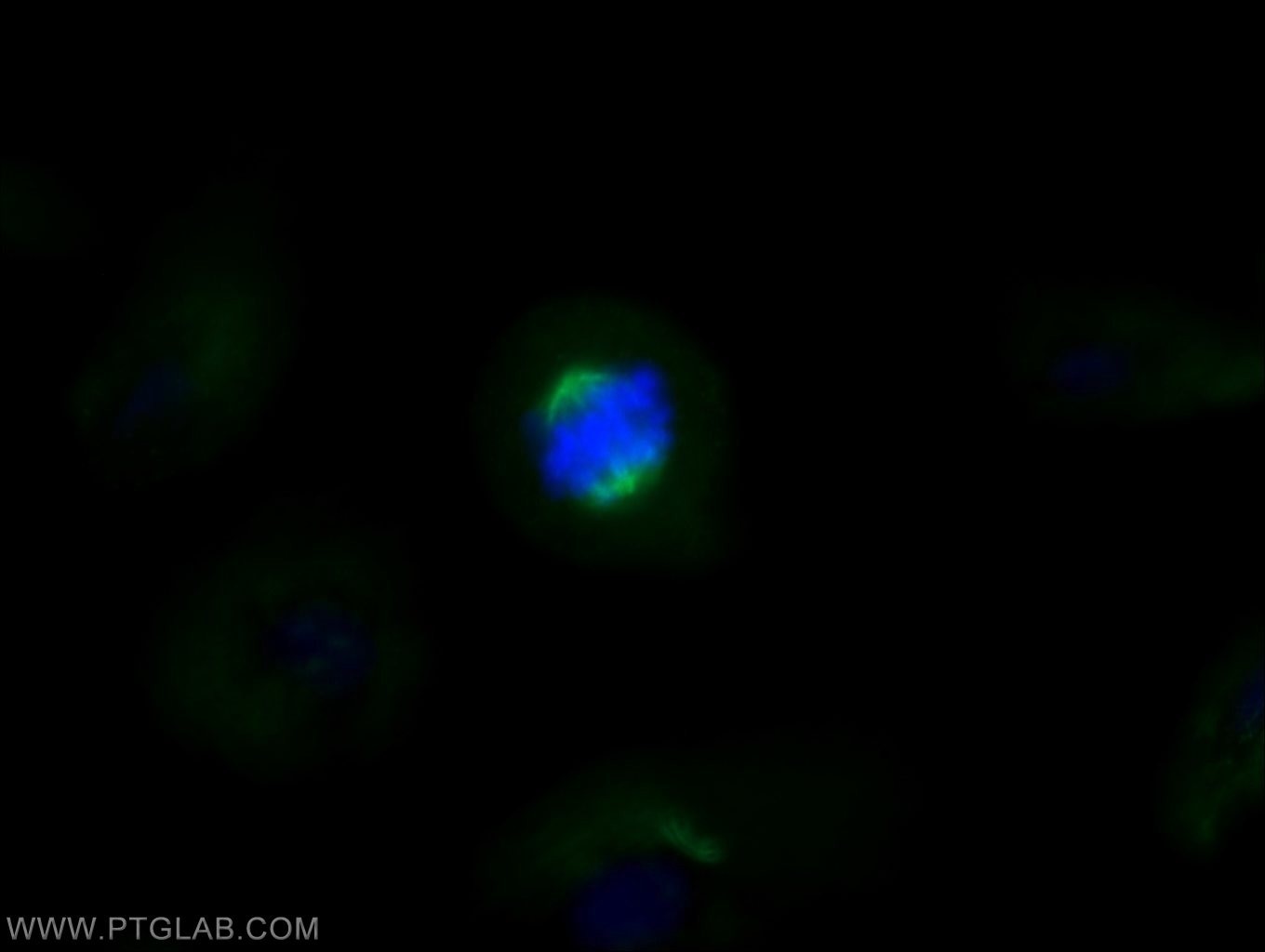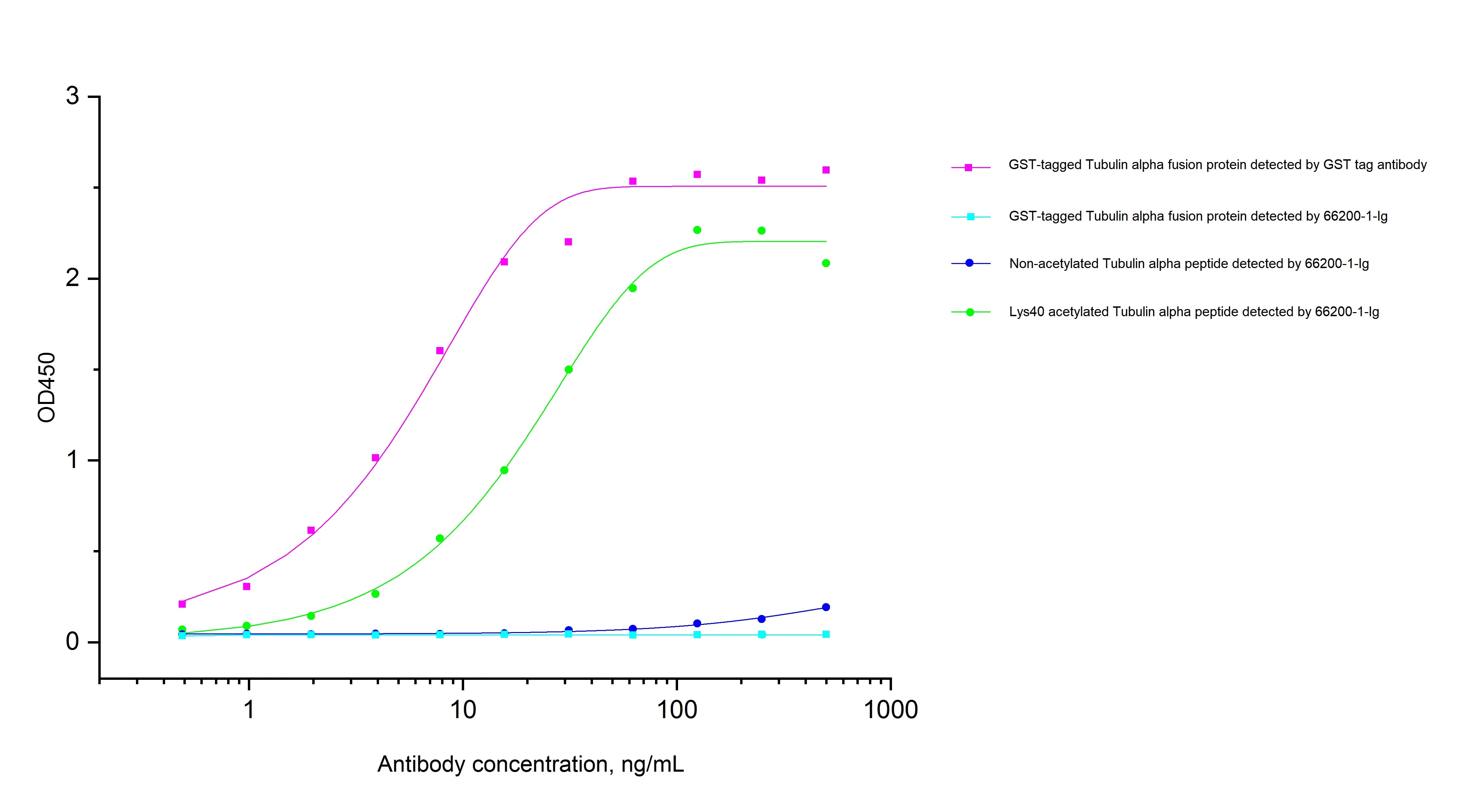Anticorps Monoclonal anti-Acetyl-Tubulin (Lys40)
Acetyl-Tubulin (Lys40) Monoclonal Antibody for WB, IHC, IF/ICC, IF-P, ELISA
Hôte / Isotype
Mouse / IgG1
Réactivité testée
canin, Humain, porc, rat, souris et plus (4)
Applications
WB, IHC, IF/ICC, IF-P, ELISA
Conjugaison
Non conjugué
CloneNo.
7E5H8
N° de cat : 66200-1-Ig
Synonymes
Galerie de données de validation
Applications testées
| Résultats positifs en WB | tissu testiculaire de rat, cellules HEK-293, cellules L02, cellules NCCIT, cellules Neuro-2a, testicule de souris, tissu cérébral de rat, tissu de cervelet de porc, tissu ovarien de souris |
| Résultats positifs en IHC | tissu ovarien de souris, tissu cérébral de rat, tissu cérébral de souris, tissu de cancer du poumon humain, tissu de gliome humain il est suggéré de démasquer l'antigène avec un tampon de TE buffer pH 9.0; (*) À défaut, 'le démasquage de l'antigène peut être 'effectué avec un tampon citrate pH 6,0. |
| Résultats positifs en IF-P | islet, tissu cérébral de souris |
| Résultats positifs en IF/ICC | cellules MDCK, cellules hTERT-RPE1 |
| Résultats positifs en ELISA | Protéine recombinante, |
Dilution recommandée
| Application | Dilution |
|---|---|
| Western Blot (WB) | WB : 1:2000-1:10000 |
| Immunohistochimie (IHC) | IHC : 1:1000-1:4000 |
| Immunofluorescence (IF)-P | IF-P : 1:10-1:100 |
| Immunofluorescence (IF)/ICC | IF/ICC : 1:200-1:800 |
| Test immuno-enzymatique (ELISA) | ELISA : 1:10-1:100 |
| It is recommended that this reagent should be titrated in each testing system to obtain optimal results. | |
| Sample-dependent, check data in validation data gallery | |
Applications publiées
| KD/KO | See 1 publications below |
| WB | See 59 publications below |
| IHC | See 4 publications below |
| IF | See 57 publications below |
Informations sur le produit
66200-1-Ig cible Acetyl-Tubulin (Lys40) dans les applications de WB, IHC, IF/ICC, IF-P, ELISA et montre une réactivité avec des échantillons canin, Humain, porc, rat, souris
| Réactivité | canin, Humain, porc, rat, souris |
| Réactivité citée | rat, bovin, canin, Drosophile, Humain, Lapin, poisson-zèbre, porc, souris |
| Hôte / Isotype | Mouse / IgG1 |
| Clonalité | Monoclonal |
| Type | Anticorps |
| Immunogène | Peptide |
| Nom complet | tubulin, alpha 1a |
| Masse moléculaire calculée | 52 kDa |
| Poids moléculaire observé | 50-55 kDa |
| Numéro d’acquisition GenBank | NM_006009 |
| Symbole du gène | Alpha Tubulin |
| Identification du gène (NCBI) | 7846 |
| Conjugaison | Non conjugué |
| Forme | Liquide |
| Méthode de purification | Purification par protéine G |
| Tampon de stockage | PBS with 0.02% sodium azide and 50% glycerol |
| Conditions de stockage | Stocker à -20°C. Stable pendant un an après l'expédition. L'aliquotage n'est pas nécessaire pour le stockage à -20oC Les 20ul contiennent 0,1% de BSA. |
Informations générales
What is the molecular weight of acetyl-α-tubulin?
The molecular weight of acetylated tubulin is 52 kD.
Where does the acetylation of Lys 40 occur?
This acetylation occurs inside the microtubule lumen by the α-tubulin acetyltransferase 1 (αTAT1) (PMID: 29207274).
How can acetylation be reversed?
Acetylation of Lys 40 can be reversed by deacetylase 6 (HDAC6), which is mostly cytoplasmic that also deacetylates Hsp90, and sirtuin 2 (SIRT2), which also mainly cytoplasmic and uses NAD as a coenzyme. Unlike HDAC6, SIRT uses both polymerized and soluble tubulin as substrates. Deacetylases are believed to be more active on soluble tubulin, while acetylases function preferentially on stable polymers (PMIDs: 29207274, 30079247, 19185337).
What is the function of acetylation?
Acetylation is a conserved post-translational modification of alpha tubulin at Lys 40 during tubulin assembly, and it correlates to increased microtubule stability and intracellular transport (PMIDs: 29207274, 30079247, 20940043).
Is acetylation of α-tubulin strictly associated with stable microtubules?
Not necessarily, as acetylation can have other effects on microtubule subpopulations (PMID 20940043).
Is ac-tubulin found only in cilia?
Acetylated-α-tubulin is located in cytoplasmic tubulin as well as in cilia; therefore, it is not strictly region-specific (PMID: 30079247).
What are the cellular effects of tubulin acetylation?
Microtubule acetylation seems to provide a critical role in neuronal development and function, and while its effect on cancer cells remains unclear, it has been shown that decreased acetylated α-tubulin impairs neuronal cell line migration. The post-translational modification may also help regulate organelle-independent signalling throughout the cell, supporting the notion of a microtubule network serving as a coordinator of cellular signaling (PMIDs: 29207274, 25503560, 20940043, 19185337).
Protocole
| Product Specific Protocols | |
|---|---|
| WB protocol for Acetyl-Tubulin (Lys40) antibody 66200-1-Ig | Download protocol |
| IHC protocol for Acetyl-Tubulin (Lys40) antibody 66200-1-Ig | Download protocol |
| IF protocol for Acetyl-Tubulin (Lys40) antibody 66200-1-Ig | Download protocol |
| Standard Protocols | |
|---|---|
| Click here to view our Standard Protocols |
Publications
| Species | Application | Title |
|---|---|---|
Cell Stem Cell Myoepithelial Cells of Submucosal Glands Can Function as Reserve Stem Cells to Regenerate Airways after Injury. | ||
Nat Aging Single-cell and spatial RNA sequencing identify divergent microenvironments and progression signatures in early- versus late-onset prostate cancer | ||
Adv Sci (Weinh) Isolation and Comprehensive Analysis of Cochlear Tissue-Derived Small Extracellular Vesicles | ||
Adv Sci (Weinh) DNALI1 Promotes Neurodegeneration after Traumatic Brain Injury via Inhibition of Autophagosome-Lysosome Fusion | ||
J Clin Invest Nasal ciliated cells are primary targets for SARS-CoV-2 replication in early stage of COVID-19. | ||
Avis
The reviews below have been submitted by verified Proteintech customers who received an incentive for providing their feedback.
FH Jianhua (Verified Customer) (01-31-2025) | excellent for western blot
|
FH Mi (Verified Customer) (05-29-2023) | Excellent antibody, it works pretty well in human white adipocytes!
|
FH Sonia (Verified Customer) (04-08-2022) | Very good specificity and sensitivity. I used for IHC in different paraffin-embedded cell blocks for different cell lines, previously analyzed by WB.
|
